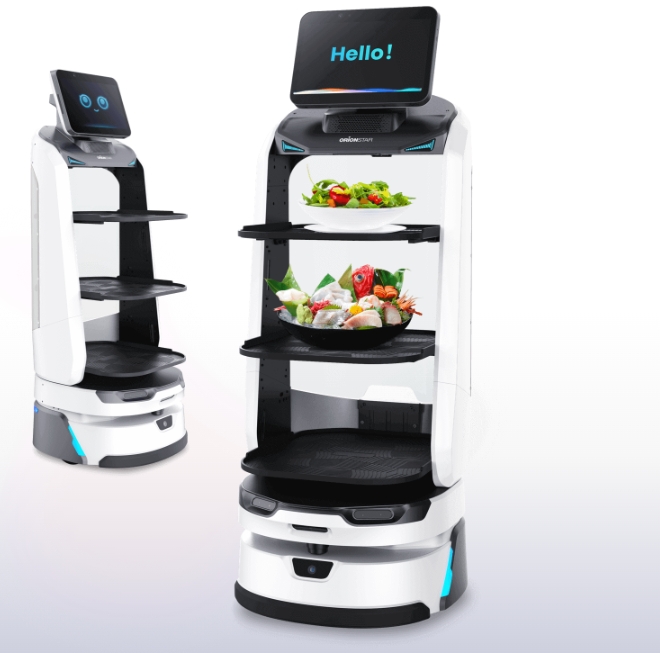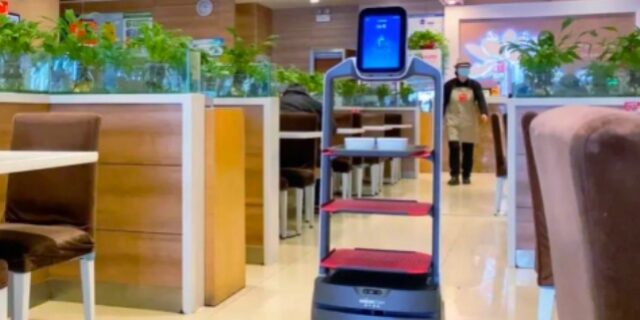Hotel delivery robots, also known as “Hotel AGV,” have revolutionized the hospitality industry by enhancing service efficiency and providing guests with an unparalleled level of convenience. But how exactly do these robots achieve precise localization and successful delivery to specific locations? This process involves the integration of several cutting-edge technologies. In this article, we will explore how hotel delivery robots navigate their environment, locate delivery points, and ensure seamless service.

1. Environmental Sensing and Map Building
One of the key capabilities of a hotel delivery robot is its ability to perceive and understand its surroundings. To achieve this, the robot integrates a variety of sensors, such as LiDAR (Light Detection and Ranging), ultrasonic sensors, infrared sensors, and high-definition cameras. LiDAR plays a crucial role by measuring the distance to objects in the robot’s environment with high accuracy, allowing it to create a 3D map of the space.
Using SLAM (Simultaneous Localization and Mapping) technology, the robot can autonomously explore and map the hotel’s interior when deployed. It identifies hallways, rooms, elevators, and staircases, building a detailed indoor map that it can refer to for navigation. This ensures that the robot knows where everything is located within the hotel, from the lobby to the top floor.
2. Robot Localization Technology
Once the hotel delivery robot has an accurate map, it needs to precisely determine its current location. Traditional GPS technology is highly effective outdoors but struggles to perform well indoors. To overcome this, hotel delivery robots rely on advanced indoor localization techniques such as Wi-Fi positioning, Bluetooth beacons, RFID (Radio-Frequency Identification) tags, or Ultra-Wideband (UWB) positioning. These technologies, combined with data from the robot’s sensors, enable it to achieve centimeter-level accuracy in determining its exact position inside the hotel.
This precise localization ensures that the robot knows its location at all times, allowing it to navigate through the hotel’s hallways and deliver items to specific rooms without errors.
3. Path Planning and Obstacle Avoidance
After determining its location, the hotel delivery robot must plan a route from its starting point to the destination. This requires sophisticated algorithms, such as the A* algorithm, Dijkstra’s algorithm, or reinforcement learning-based path planning. The robot considers various factors like distance, time, and obstacle distribution to choose the most efficient route.
To ensure smooth navigation, the robot is equipped with obstacle avoidance systems. When it encounters an obstacle, such as furniture or guests, it can quickly react by recalculating its path or stopping momentarily to avoid collisions. This ability to dynamically adjust its route in real-time ensures both safety and efficiency in delivery.
4. Intelligent Interaction and Task Allocation
Another key component of hotel delivery robots is their intelligent interaction system. Guests can place orders via a mobile app, voice assistant, or through the hotel front desk. Once an order is placed, the system sends the delivery task to the nearest available robot. Upon receiving the task, the robot automatically moves to the specified location, retrieves the items, and interacts with the guest via a built-in screen, voice prompts, or the mobile app to confirm delivery details.
Hotel management systems can also dynamically assign tasks to robots based on their current status and location, ensuring that no robot is overloaded and that tasks are completed efficiently.
5. Multi-Scenario Adaptability and Special Functions
Hotel delivery robots are designed to adapt to various complex environments within the hotel. For instance, in elevator scenarios, the robot can automatically detect elevator doors and press the appropriate floor button. At room entrances, it can recognize door numbers and deliver items accurately. Advanced delivery robots may also feature facial recognition, voice interaction, and autonomous charging capabilities, further enhancing their intelligence and functionality.
Conclusion
Hotel delivery robots are transforming the guest experience by utilizing cutting-edge technologies like SLAM, LiDAR, and indoor localization systems. From building detailed maps of their surroundings to delivering items with pinpoint accuracy, these robots make hotel service more efficient and convenient for guests. As technology advances, the capabilities of these robots will continue to expand, offering even more personalized and intelligent service.
Call to Action: If you’re looking to integrate smart solutions like delivery robots into your hotel, consider CPJ ROBOT. Specializing in manufacturing delivery robots, navigation robots, and hotel robots, CPJ ROBOT offers customizable OEM & ODM options with multi-functional and multilingual support. Contact us today to inquire about how we can tailor our robots to meet your specific needs.






